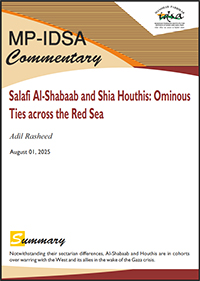Salafi Al-Shabaab and Shia Houthis: Ominous Ties across the Red Sea
- August 01, 2025 |
- IDSA Comments
Salafi–Shia jihadists in Cohorts
Notwithstanding their sectarian differences, Al-Shabaab and Houthis are in cohorts over warring with the West and its allies in the wake of the Gaza crisis. Al-Shabaab and Ansar Allah have joined hands in disrupting international maritime and naval networks on the Red Sea, which connects the Indian Ocean to the Mediterranean Sea and beyond, through the Bab el-Mandeb Strait and the Suez Canal. With the help provided by Houthis and Iran, Al-Shabaab has increased its insurgent attacks in Somalia and has gained more territory and sway in recent months.
Al-Shabaab and the Jarudi Zaydi Shia movement of Ansar Allah began forging non-aggression pacts at least since 2022.[2] With AQAP adopting a more pan-Islamist approach as a non-takfeeri movement (no longer prone to labelling non-Salafi Muslims as infidels and therefore fit for slaughter), it has allowed its affiliate Al-Shabaab to cooperate with the Houthis in the field of security and intelligence, providing safe havens to each other in times of crisis, and in coordinating efforts to target forces of their adversaries.[3] In addition, a recent Carnegie Endowment for International Peace report states: “To supply Ansar Allah (Houthis), the IRGC (Iranian Revolutionary Guard Corps) relies on Somali piracy networks, Al-Shabab, and arms dealers in Yemen and Somalia.”[4]
The relationship between Iran (currently ruled by a Twelver Shia theocracy) and Salafi-jihadist Al-Qaeda has not always been adversarial. Still, it has been marked by periods of cooperation and conflict. According to US diplomatic sources, Iran had played a role even in helping the perpetrators of the 9/11 attacks, as US intelligence sources claim that at least eight of the 9/11 hijackers travelled through Iran between October 2000 and February 2001.[5]
Some US government reports even accuse Iran of allowing Al-Qaeda to move funds and fighters to South Asia and Syria, among other locales, since at least 2009.[6] Another study published by the Abu Dhabi-based Emirates Policy Centre (EPC) alleges that Iran funded attacks by Al-Qaeda against US troops in Iraq between 2003 and 2011.[7]
Smuggling of Illegal Small Arms and Advanced Weapons
Therefore, allegations that Iran is threatening US interests in the Red Sea and Africa by forging links with Al-Qaeda affiliate Al-Shabaab in the Horn of Africa do not seem far-fetched to many security experts.[8] In 2021, a study by the Global Initiative against Transnational Organized Crime stated that Iran’s supply of small arms and light weapons to Houthi rebels for use in Yemen’s civil war was first smuggled to Somalia, where they were handled by operatives like Al-Shabaab, “through the Puntland entry point”.[9]
However, this trade in illicit weapons has now risen to include even highly advanced and sophisticated weapons. According to the United Nations Security Council report issued on 28 October 2024, the United States Navy ship the USS Lewis B. Puller intercepted a flagless dhow (named Yanus) off the coast of Somalia in January 20224, while it was smuggling ballistic and cruise missile components, including propulsion, guidance and warheads for medium-range ballistic missiles and anti-ship cruise missiles.[10] It is also believed that by cooperating in the smuggling of weapons with the Houthis, Al Shabaab has also gained for itself advanced weapons and related training from the Houthis, including the use of weaponised drones.[11]
Al-Qaeda on the Ascendant in Africa
According to the Africa Centre for Strategic Studies,
Al Shabaab has demonstrated greater capabilities and the deployment of drones in its 2025 offensive, where it was able to retake considerable amounts of territory that the government of Somalia had gained in previous years.[12]
On 27 July 2025, Al-Shabaab seized control of the vital town of Maxaas, a strategic hub for transport and logistics in the central region.[13] This news comes as a blow to the beleaguered government forces protecting the Somali capital, Mogadishu. It has increased threat perceptions across East Africa, especially in Ethiopia, Somalia, Djibouti and Kenya.[14]
As the spectre of Al-Shabaab grows in eastern Africa, another Al-Qaeda affiliate by the name Jama’at Nusrat al-Islam wal-Muslimin (JNIM) is rapidly gaining territories in Africa’s Sahel region, through a vigorous, new offensive launched on 1 July 2025, after which seven towns in western Mali, bordering Senegal and Mauritania, have been captured. According to a BBC report, “There is growing concern about the impact JNIM could have on the stability of the region … (as) Burkina Faso, Mali and Niger have struggled to contain the violence.”[15] With French forces approaching complete withdrawal from the Sahel region and the loss of the US drone base in Niger, anti-terrorism surveillance has become difficult[16] in countering a resurgent JNIM.
Some experts fear that with its increased cooperation with Al-Shabaab in East Africa, Iran might be tempted to promote its influence with other Al-Qaeda organisations extending to West Africa. According to the EPC study mentioned earlier,
Iran wants to recruit Al-Shabaab and link it to other Iranian-sponsored movements in West Africa … Iran hopes to extend its influence from the Sahara to the Somali coast.[17]
No Excess Baggage with Iran
It is remarkable that despite being a Shiite state, Iran has been able to challenge even the growing influence of Sunni Turkey in Africa. According to an Egyptian analyst, Hisham Al-Najjar, as early as 2020, Iran’s approach to reaching out to Sunni jihadist groups in Africa seemed more effective than the one adopted by Turkey.[18]
As a Shia benefactor of African jihad, Iran is aware of its limitations. Thus, it pursues a highly cautious and non-abrasive approach, based on clearly defined parameters of cooperation aimed at defeating Islam’s supposed adversaries (i.e., the West and its allied forces). Thus, Iran takes pains to keep sectarian issues out of its dealings with African jihadist groups, which share Iranian views about the misrule of Arab leaders and supposed conspiracies of Western powers.
Thus, Al-Najjar states:
The model of the relationship between the Somali Al-Shabaab movement and Iran demonstrates that the latter is keen to ensure that its relationship with Sunni armed groups in general does not descend to the level of exploitation and blackmail, as is the case with Turkish practices.[19]
Although Sunni Egypt and Turkey’s influence is increasing in the Horn of Africa, often to offset landlocked Ethiopia’s aspirations to gain access to the sea through Somaliland and Puntland, Al-Shabaab resents being used by Turkey as a tool for blackmail, bargaining, and promoting Turkish geopolitical interests.
Al-Shabaab leader Ahmed Diriye Abu Ubaidah has openly expressed his distrust of Turkey and criticised its support for the Somali government. In an audio recording of his speech aired a few years back on Al-Shabaab’s radio channel, titled “Sharia or Martyrdom”, Ahmed Diriye reportedly accused Turkey of plundering his country’s wealth and economically invading it, describing it as an enemy of the nation.[20]
Thus, despite the conflicting religious doctrinal views of Shia Iran and Salafi Sunni Al-Shabaab, the latter finds itself more comfortable in dealing with its Iranian backers, where both sides deal with each other on equal terms, than with other Sunni states liaising with it in secret.
As the threat of another imminent Israel–Iran showdown continues to loom large, Tehran seems desperate in its search for more proxies—even if it means reaching out to Salafi jihadist forces in Africa.
Views expressed are of the author and do not necessarily reflect the views of the Manohar Parrikar IDSA or of the Government of India.
[1] Michael Horton, “Looking West: The Houthis’ Expanding Footprint in the Horn of Africa”, Combating Terrorism Centre at West Point, Vol. 17, No. 11, December 2024.
[2] “Letter dated 6 February 2025 from the President of the Security Council Resolutions 1267 (1999), 1989 (2011) and 2253 (2015)”, S/2025/71, United Nations Security Council, 6 February 2025.
[3] “Letter dated 11 October 2024 from the Panel of Experts on Yemen addressed to the President of the Security Council”, S/2024/734, United Nations Security Council, 11 October 2024.
[4] Ibrahim Jalal and Adnan Al Jabrani, “Dhows, Drones, and Dollars: Ansar Allah’s Expansion into Somalia”, Carnegie Endowment for International Peace, 14 March 2025.
[5] Michael R. Pompeo, Secretary of State, “The Iran-Al Qaeda Axis”, US Embassy Tbilisi, 13 January 2021.
[6] “Country Reports on Terrorism 2021: Iran”, US Department of State, 2021.
[7] “The Growing Relationship between Iran and al-Shabab Movement in Somalia: Motives and Potential Consequences”, Horn of Africa Studies Unit, Emirates Policy Centre, 27 July 2020.
[8] Suhaib Abdulrahman, “Why is Iran Violating the Arms Embargo and Supporting Terrorism in Somalia?”, Hafryat, 2 August 2018.
[9] Mohammad Dhaysane, “Iranian Arms Being Smuggled from Yemen into Somalia: Report”, Anadolu Ajansi, 11 November 2021.
[10] “Letter dated 11 October 2024 from the Panel of Experts on Yemen addressed to the President of the Security Council”, no. 3.
[11] “Letter dated 6 February 2025 from the President of the Security Council resolutions 1267 (1999), 1989 (2011) and 2253 (2015)”, no. 2.
[12] “Expanding Al Shabaab–Houthi Ties Escalate Security Threats to Red Sea Region”, Africa Center for Strategic Studies, 28 May 2025.
[13] “Key Somalia Town of Maxaas Falls to Al-Qaeda-linked Al-Shabaab After Heavy Fighting”, The Arab Weekly, 28 July 2025.
[14] Karen Allen, “Houthis in Somalia: Friends With Technological Benefits?”, Institute for Security Studies (ISS), 10 June 2025.
[15] Priya Sippy and Jacob Boswall, “How an al-Qaeda Offshoot Became One of Africa’s Deadliest Militant Groups”, BBC, 7 July 2025.
[16] Olayinka Ajala, “West Africa Terror: Why Attacks on Military Bases are Rising – and Four Ways to Respond”, The Conversation, 7 July 2025.
[17] “The Growing Relationship between Iran and al-Shabab Movement in Somalia: Motives and Potential Consequences”, Horn of Africa Studies Unit, Emirates Policy Centre, 27 July 2020.
[18] Hashem al-Najar, “Somalia’s Al-Shabaab Strengthens Relationship with Iran at Turkey’s Expense”, Al-Arab, 20 January 2020.
[20] Al-Najjar, “Somalia’s Al-Shabaab Strengthens Relationship with Iran at Turkey’s Expense”.
[21] Ibid.






